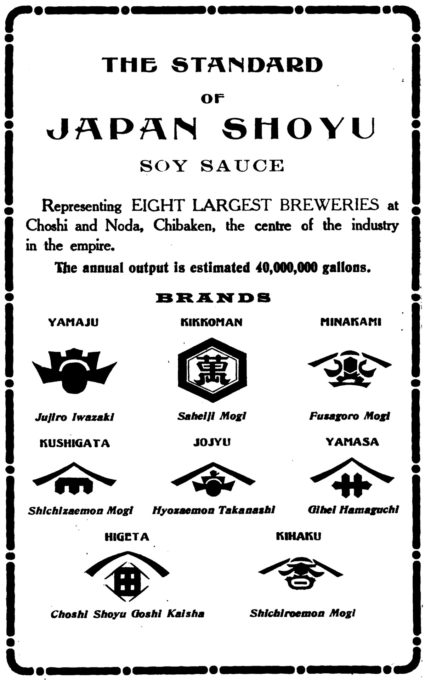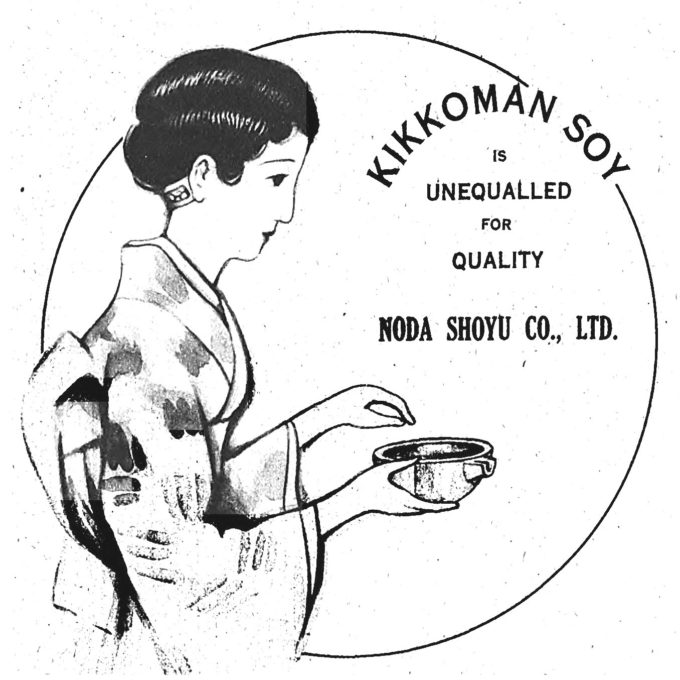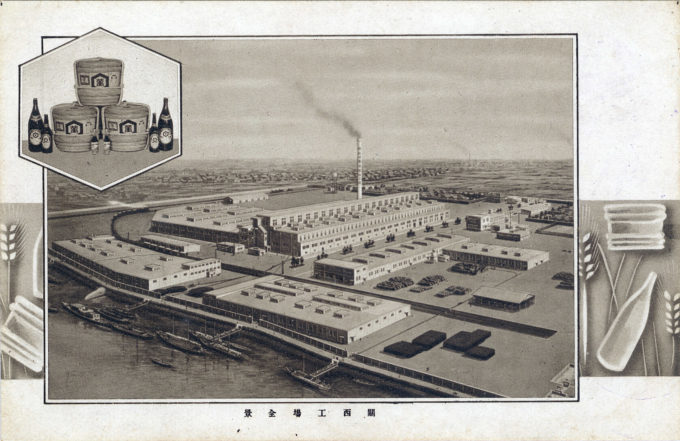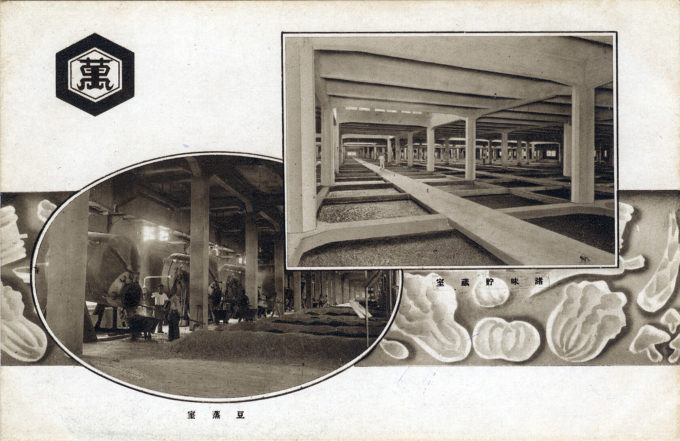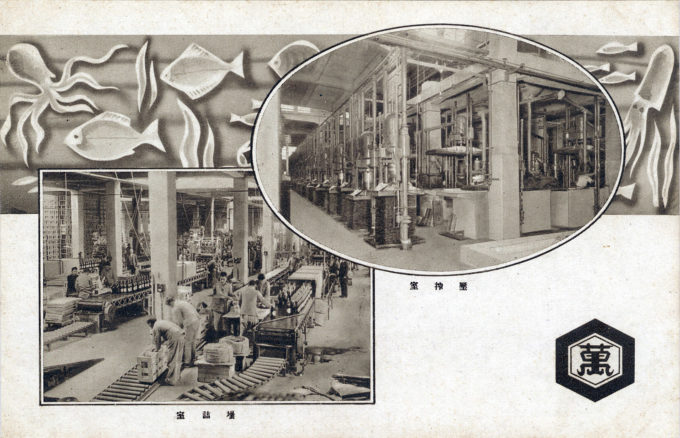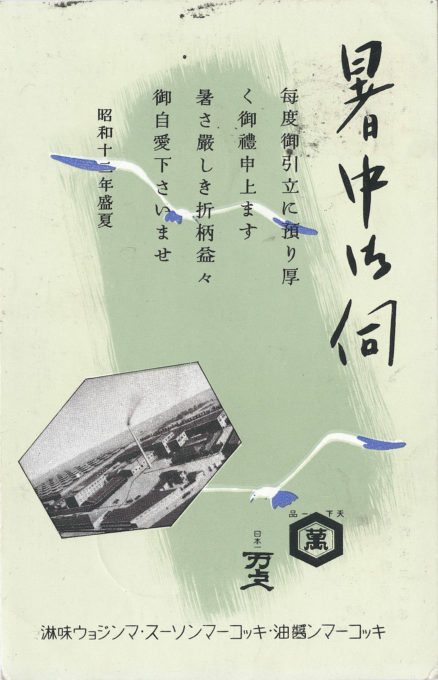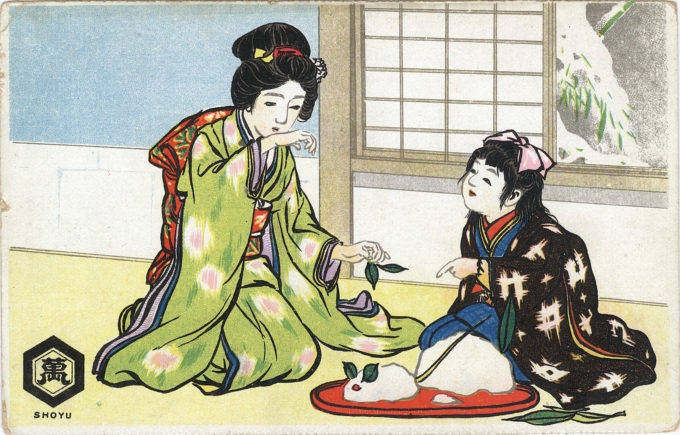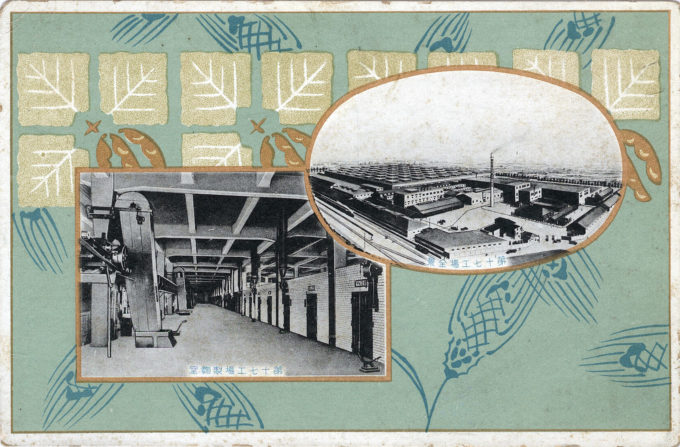
An aerial view of the Kikkoman shoyu factory at Noda, Chiba Prefecture, c. 1930. When it was first opened in 1926, Factory 17 (as it was known) boasted the largest and most mechanized shoyu production facilities in the world with an annual production capacity of over 6.7 million gallons.
See also:
Cape Inubosaki lighthouse, Choshi, Chiba Prefecture, Higeta Shoyu Co. advertising postcard, c. 1930.
Meiji “Merry Brand” Sweetened Condensed Milk, c. 1930.
“Calpis” beverage advertising postcard, 1924.
“Modern Shampoo” advertising postcard, c. 1935.
“The Kikkoman trademark is a hexagon, representing the pattern of a tortoise shell, within which is written ‘萬’, calligraphy for ‘10,000’. The name ‘Kikkoman’ is a combination of the word kikko, which means ‘tortoise shell’, and man, which translates to ‘10,000’. In Japan, the tortoise is a symbol of steady progress and longevity as, according to folklore, it was believed to live as long as 10,000 years.
Chiba Prefecture shoyu manufacturers advertisement, 1915, including Mogi Cos.’s “Kikkoman” brand. [Source: Japan and Her Exhibits at the Panama-Pacific International Exhibition souvenir booklet]
“The history of Kikkoman soy sauce dates back to the 17th century, when the forefathers of the Mogi, Takanashi, and Horikiri families began to produce the dark brown seasoning sauce from soy, wheat, water and salt in the Japanese town of Noda, in Shimōsa Province [now parts of Chiba and Ibraki prefectures] east of Edo. The city’s optimum location on the banks of the River Edo provided convenient access to raw materials and prompt deliveries to the expanding city of Edo, which is today called Tokyo.
“By the early 1800s the Noda producers were the largest shoyu makers in Japan, and it was at about this time a shoyu manufacturers guild was formed in the area. The two largest guild members were Mogi Shichirouemon and Mogi Saheiji. While the former attempted to expand his market share by a carefully planned program of inter-family marriage alliances, the latter took a different course.
“In 1838 Mogi Saheji petitioned for and received central government registration of his family’s brand name ‘Kikkoman’, first used commercially in 1782. With this he unknowingly began a long crusade that would eventually result in this private label becoming the world’s most popular brand of shoyu. In 1838 Kikkoman was designated as the brand of shoyu to be supplied to the Tokugawa shoguns.
“After the Imperial Restoration (1868), when shoyu exports to Europe began in earnest, in an era before legal trademark registration, complex and detailed gold brand labels were ordered from Paris and those were pasted on Kikkoman’s shoyu export kegs. In 1879 ‘Kikkoman’ was registered in California as a legally recognized brand name; it acquired the same legal protection in Japan in 1885 and in Germany in 1886.
Noda Shoyu Co., Kikkoman soy sauce advertisement, 1927. [Source: The Asahi English Supplement, 1927.]
“In 1917, the three original families [Mogi, Takanashi, and Horikiri] merged their businesses to form Noda Shoyu Co., Ltd. In 1925 the company underwent a major reorganization and recapitalization when five companies, including Noda Shoyu, specializing in the production of shoyu, sake, and miso, were joined by four others in the fields of transportation and finance to form a giant rural zaibatsu holding company, Noda Shoyu Brewing Co. A corporate name change to Kikkoman Shoyu Co., Ltd. happened in 1940, with the name further altered in 1980 to the company’s present name: Kikkoman Corporation.
“In April 1926, using its new capital, Noda Shoyu Co. opened in Noda what was probably the largest and most mechanized shoyu plant in the world. Called Factory 17, it boasted manufacturing floor space of 48,501 square meters and a production capacity of 6,720,000 gallons. Then in 1929 the even larger Takasago production plant was built in western Japan, near Kakogawa, about 45 miles east of Osaka.”
– Kikkoman Company history
- Kikkoman’s Kakogawa shoyu factory at Takasago, Osaka, c. 1930. Steamed soy beans are mixed with crushed, roasted wheat into a paste with koji starter (left). The moromi mash is then aged and fermented for several months in large pools (right).
- Kikkoman’s Kakogawa shoyu factory at Takasago, Osaka, c. 1930. The moromi is mechanically pressed and sauce extracted from the mash (right). Then, after clarification and heating to stop fermentation, the soy sauce is bottled and labeled (left) for distribution and sale.
“Japanese soy, called shoyu by the people of the country, is a sauce peculiar to the Orient; and the kind produced in Japan is different from that used by other oriental countries.
“Originally, like many other things, it may have come from China, but it is different from that now used in China, and the history is too complicated to persue.
A New Years postcard from Noda Shoyu Brewing Co., 1937, highlighting the company’s three products: Kikkoman shoyu (soy sauce), Kikkoman Sauce (a thick, sweet sauce), and Kikkoman mirin (sweetened rice wine). The caption reads: “Thank you for your continued patronage / It has been a hot and humid season / Please take care of yourself”.
“… Although soy sauce has been used in Japan for centuries, it was for a long time made by individuals for their own use, much as western people often make their own pickles, but in recent years the making of shoyu has become a national industry. The sauce is now a product of numerous centers of manufacture in Japan: Yuasa in the province of Kii, Noda in Choshi, and Tatsuno in Harima being among the most noted. It is said that soy sauce first began to be made in these as far back as 600 years ago; certainly no later than 300 years ago.
“Just when Japanese soy sauce became so well known abroad as to lead to exportation of it is not now known, but there is mention of shoyu being exported by a Dutch firm at Nagasaki in 1818, when it was sent to India, probably the Dutch East Indies, where it was changed to resemble foreign sauce and re-exported to Europe.
“Somewhere about the year 1880 the then-Minister of Finance, Count Sano, made investigation of the matter, and went the length of expressing the conviction that such sauces as Worcestershire were but an imitation of Japanese shoyu, if the very name, ‘sauce’, itself was not a corruption of the word ‘shoyu’. Though this was but a mere fancy, it showed that Japan as awaking to the fact that she had a sauce superior to anything of the kind produced in western lands and that she must take steps to have it better known and more used.
“… There is hardly a corner of the earth where it is not in demand. The total annual value of exported soy sauce is over one million yen; and every year sees further increase. Japanese shoyu has a peculiarly delicious flavor that all foreigners relish. For fish there is nothing that can compare with it. It is equally pleasant with meats and vegetables.
“That Japanese soy sauce may have had some influence on the production and quality of similar sauces in the west is seen from the fact that Worcestershire sauce, for example, did not appear on the market until about 1854, some time after the Japanese article had begun to be known in the west.
“… The special merit of Japanese shoyu was first acknowledged internationally at the Paris Exposition in 1900 when the exhibit was awarded a special medal, the English Worcestershire sauce obtaining only a copper medal … The sauce that took the highest award a the Paris Exposition was [of] French production, which in reality was only Japanese shoyu made over to suit the taste of Europeans, but the chief flavor of it was Japanese.”
– “Making Shoyu”, by M. Taguchi, The Japan Magazine, March 1916

An aerial view of Kikkoman’s Kakogawa shoyu factory and administrative building at Takasago, Osaka, c. 1930. Shoyu (soy sauce) is made from four basic ingredients: soybeans, wheat, salt and water. A proprietary form of koji mold, Kikkoman aspergillus, is then added in the Kikkoman-branded fermentation process.


